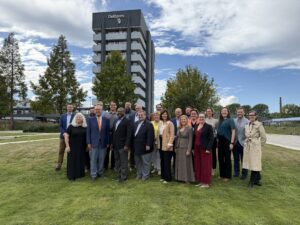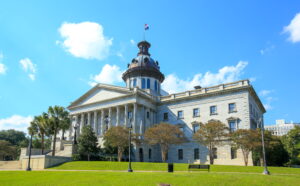April 21, 2021
—
AFC’s blueprint for a federal infrastructure bill that enhances flood resilience and strengthens communities
With the potential for unprecedented federal investment in infrastructure, this month could mark the beginning of a new era of flood resilience. Kicking off deliberations in Congress, the Biden administration recently proposed a $2 trillion infrastructure plan, at least $50 billion of which is dedicated to improving infrastructure resilience.
While the scope, process, and ultimate fate of this plan remains uncertain, the need for major investments in flood-resilient infrastructure is clear. From 2000 to 2017, flood-related disasters in the U.S. accounted for more than $750 billion in losses, making it the costliest and most frequent disaster threat in the nation.
Facing increasing frequency and severity of floods and economic fallout from COVID-19, the U.S. has a once-in-a-generation opportunity to enact solutions that protect people and property, expand equitable delivery of resources, and revitalize communities while creating jobs.
What is AFC proposing?
AFC recently unveiled a dozen comprehensive funding and policy priorities for inclusion in a federal infrastructure plan that would commit at least $38.2 billion and enhance policies for flood mitigation, resilience, and disaster preparedness programs in the U.S. According to AFC’s research in partnership with Johns Hopkins University, this level of investment could create as many as one million jobs — a much needed boost to the country’s economic recovery in the wake of COVID-19.
AFC’s priorities span two categories: new, innovative concepts that expand resilience solutions; and proven, existing programs that serve communities. Below is a breakdown of AFC’s requests in each category:
New, innovative concepts
- Create and invest in a Resilient Infrastructure Pre-Development Fund to fill technical and capacity gaps in smaller, rural, and underserved communities. This fund would help communities complete critical yet often prohibitively costly steps — such as environmental and economic planning and assessments, as well as zoning and permitting work — to unlock federal investment in resilient infrastructure projects.
- Establish Infrastructure Resilience Accelerators that rapidly scale resilient infrastructure projects and ultimately close the technical capacity gap in states and municipalities. To leverage and strengthen local networks, accelerators could be affiliated with community colleges, as well as Historically Black Colleges and Universities, Tribal Colleges and Universities, and other minority-serving institutions.
- Develop a Small Business Administration (SBA) Pre-Disaster Loan Program to help small businesses prepare for disasters. With so many businesses struggling from economic stagnation during COVID-19, this program would help entrepreneurs proactively protect physical property, goods, and supplies from damage, while reducing future recovery costs.
- Implement a federal grant program to reinforce, upgrade, or realign existing transportation infrastructure to be more resilient to extreme weather. Previously reflected in proposed legislation as the Promoting Resilient Operations for Transformative, Efficient, and Cost-saving Transportation (PROTECT) program, this concept would create jobs while reducing federal disaster recovery costs.
- Direct seed money for states to establish revolving loan funds for hazard mitigation. As part of the recently enacted STORM Act, such funds would help states accelerate projects that minimize disaster risks from flooding and storm surge.
- Fund pre-disaster infrastructure mitigation at the Federal Highway Administration (FHWA) to proactively address vulnerabilities and improve long-term resilience of FHWA infrastructure. Investing before natural disasters strike would ease pressure on post-disaster resources and save taxpayer dollars.
Proven, existing programs
- Increase overall funding for FEMA’s Building Resilient Infrastructure and Communities (BRIC) program and expand access to the program by directing more resources for technical assistance and outreach. As one of the only federal programs dedicated to pre-disaster mitigation, BRIC project funding is in high demand. During BRIC’s first grant cycle, the program received project requests totaling $3.6 billion, seven times more than the $500 million in available funding.
- Devote substantial resources for mitigation and adaptation measures at U.S. military bases to support military readiness against flooding, sea level rise, and natural disasters. Beyond advancing national security, this investment would stimulate local economies around bases and minimize future disaster costs.
- Fund authorized Army Corps of Engineers projects that reduce flood risk. Tackling the Corps’ roughly $96 billion project backlog would expand resiliency, achieve savings in future disaster recovery, and catalyze economic development nationwide.
- Authorize and fund a grant program for shovel-worthy coastal resilience projects that restore and protect coastlines. In addition to protecting coastal communities, wetlands and wildlife habitat-focused projects would benefit commercial fishing and tourism industries that have been hard-hit by COVID-19.
- Appropriate additional funding for FEMA’s Flood Mitigation Assistance (FMA) grant program to help states, tribes, and territories fund projects that reduce or eliminate flood risk for buildings insured by the National Flood Insurance Program (NFIP). Doing so would reduce future NFIP claims and help communities proactively address flood risk.
- Expand investment in Sewer Overflow and Stormwater Reuse Municipal Grants to help communities upgrade and replace aging sewer systems. Additional resources for this program would make drainage systems more resilient, reduce water pollution, and improve public health for hundreds of municipalities.
Anchored in data and research, AFC’s vision for resilient infrastructure builds off of proven programs and reflects sound policy that can garner consensus across the political and geographic spectrum.
How will the federal infrastructure debate unfold?
Over the coming weeks and months, committees in the House and Senate will craft bills that build on aspects of President Biden’s proposal and comprise a broader infrastructure package. Because both chambers of Congress are narrowly under Democratic control, Democratic leadership and committee chairs will primarily drive these efforts. At the same time, both parties recognize the need to invest in infrastructure and have stressed the importance of achieving bipartisan consensus — a priority for the Biden administration as well.
AFC will lift up its priorities through education and outreach, collaboration with external partners, and of course, elevating the needs and perspectives of AFC’s more than 240 members and Federal Champions who are on the frontlines of all types of flooding.
Why do AFC’s requests matter?
Though AFC’s approach to strengthening resilient infrastructure spans many federal agencies and programs, its impact will support our members and their communities. With this objective in mind, AFC’s recommendations align with coalition policy priorities including expanding technical capacity; increasing equity for historically underserved, smaller, and rural communities; driving economic growth; and reducing future disaster risk.
With both the challenges of flooding and the opportunities to revitalize communities, AFC looks forward to integrating its requests into an infrastructure package that protects lives and livelihoods and ensures a more resilient future for all.






